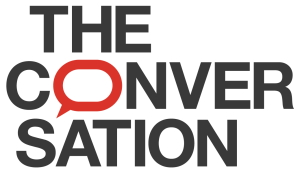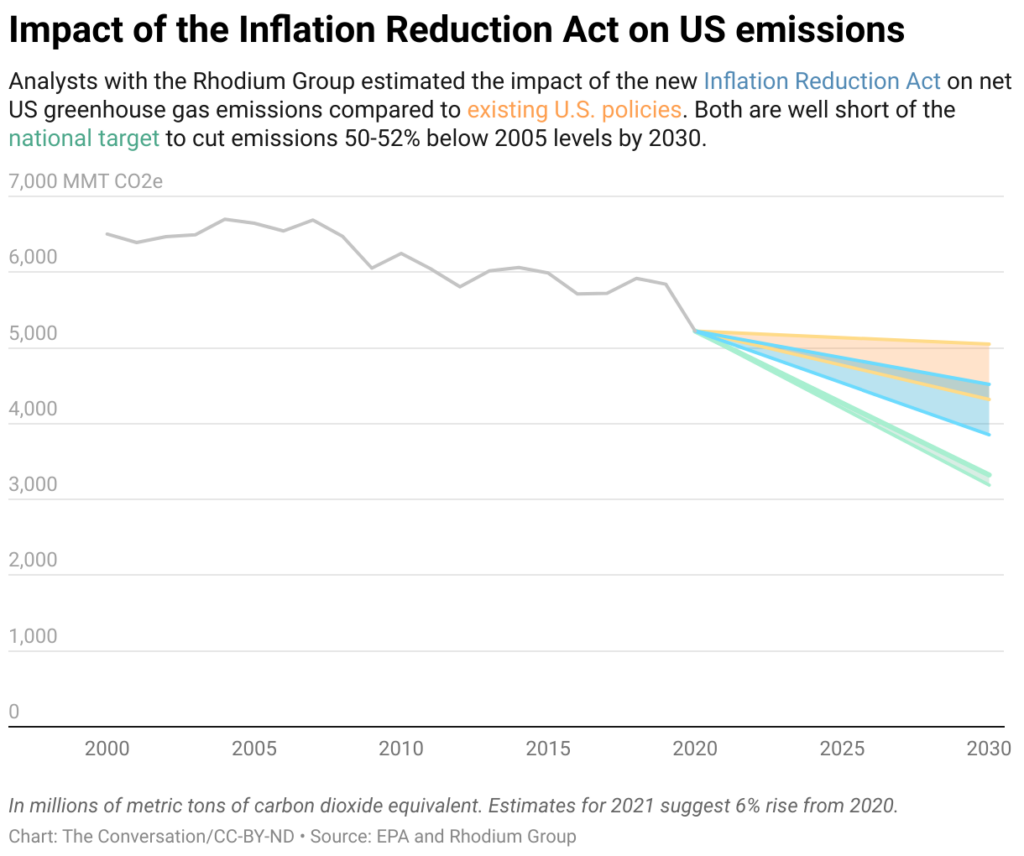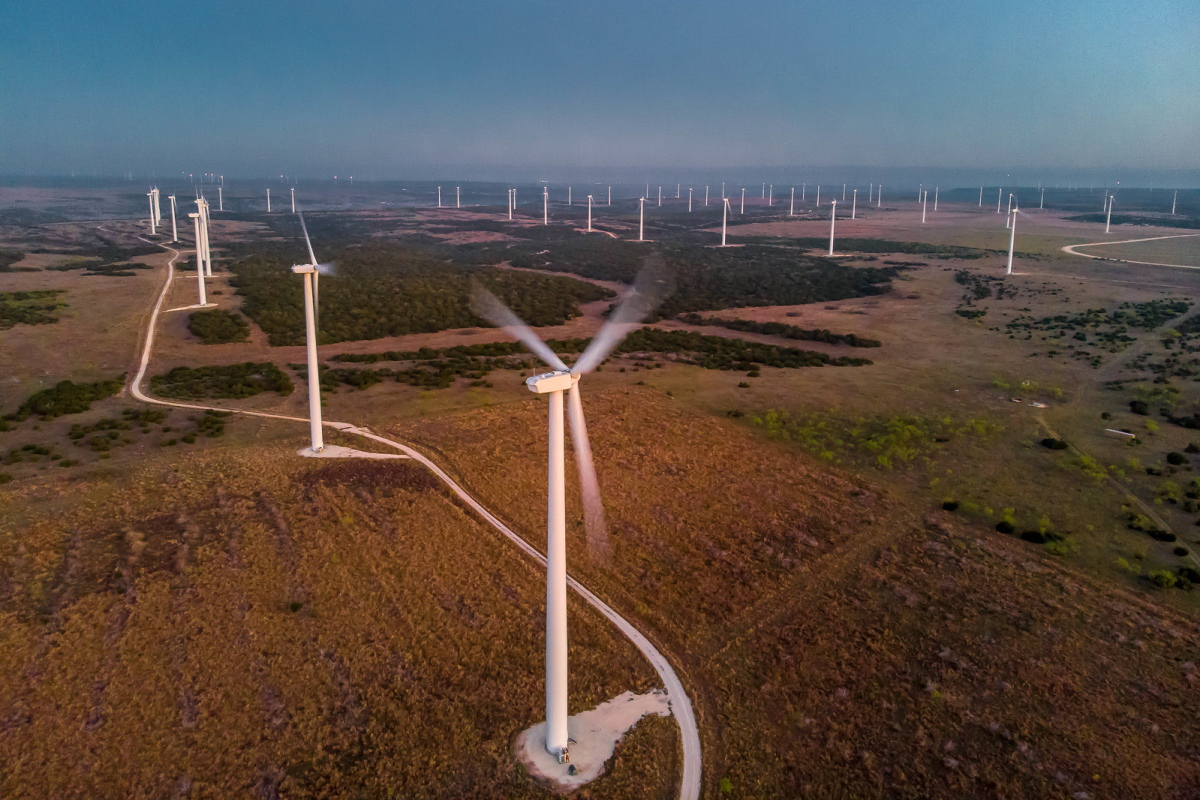The Inflation Reduction Act was only a first step. Two outcomes matter: how deeply U.S. actions reduce domestic emissions, and how effectively they reduce the costs of clean technologies so that other countries can also reduce their emissions.
A wind farm at sunrise near Nolan, Texas. Daxis, CC BY-ND 2.0, via flickr
 This article was originally published by The Conversation, an independent, nonprofit news organization that produces articles written by academic experts for the general public and edited by a team of journalists.
This article was originally published by The Conversation, an independent, nonprofit news organization that produces articles written by academic experts for the general public and edited by a team of journalists.
The new Inflation Reduction Act is packed with subsidies for everything from electric vehicles to heat pumps, and incentives for just about every form of clean energy. But pumping money into technology is only one step towards solving the problem of climate change.
Wind and solar farms will not be built without enough power lines to connect their electricity to customers. Captured carbon and clean hydrogen won’t get far without pipelines. Too few contractors are trained to install heat pumps. And EV buyers will think twice if there aren’t enough charging stations.
In my new book on Climate Solutions, I address these and other obstacles that stand in the way of the clean energy transition. Overcoming them is the next step as the country figures out how to deliver on the goals of the most ambitious climate legislation Congress has ever passed.
Two outcomes matter: how deeply U.S. actions reduce emissions domestically, and how effectively they reduce the costs of clean technologies so that other countries can also reduce their emissions.
Infrastructures and obstacles
Various studies predict that the Cut Inflation Act will reduce greenhouse gas emissions in the United States by about 40% below their 2005 levels by 2030. This represents a reduction of about 1 billion tons per year, far more than any other US law.
But that still leaves a gap of about 10 percentage points from President Joe Biden’s goal of at least 50% emissions reductions by 2030.

What will it take to close this gap?
The Cut Inflation Act grants will make clean tech cheaper, but the biggest need domestically is for more infrastructure and tougher environmental regulations.
For infrastructure, electric car tax credits will be useless without enough publicly available chargers. The United States has about 145,000 gas stations, but only about 6,500 fast-charging stations that can quickly recharge a battery for a driver on the go.
More than 1,300 gigawatts of wind, solar and battery projects – several times the existing capacity – are already waiting to be built, but have been delayed for years by a lack of grid connections and lagging approval processes. by regional network operators.
The Infrastructure Investment and Jobs Act passed by Congress last year provides funding for chargers, power lines and pipelines, but far from enough. For example, it sets aside only a few billion dollars for high voltage power lines, a tiny fraction of the hundreds of billions of dollars needed to pave the way to net zero emissions. Its $7.5 billion for chargers is only a third of what the electric car advocates project will need.
Even more important is removing regulatory barriers to building clean energy infrastructure.
Senate and House Democratic leaders have pledged to pass legislation making it easier to obtain permits for power lines and pipelines, but that would require bipartisan support, and that remains uncertain.
State and local governments and regional grid operators also play a central role in approving new infrastructure and clean energy projects. They must overcome the opposition that is not in my backyard – partly from the policy makers themselves – to the power lines, pipelines and facilities that will be needed for clean energy, and simplify the processes of approval of rooftop solar panels.
Not everything can be carrots: you also need sticks
We will also need regulatory sticks to complete the Inflation Reduction Act Carrot Cake Buffet.
By tightening limits on emissions of greenhouse gases and other air pollutants under its authority under the Clean Air Act, the Environmental Protection Agency can spur the closure of old power plants fossil fuels, mandate carbon capture in the news and drive emissions reductions across a range of industries.
Stricter emissions limits could force gasoline and diesel vehicles to become more efficient and accelerate the adoption of electric vehicles. Stricter reporting rules and better monitoring of methane leaks will be needed to prop up the law’s only stick on curbing inflation – its tax on methane emissions.
States also wield powerful regulatory batons. Ten states have already established standards for 100% clean or renewable electricity. California and Oregon have set requirements for cleaner fuels, and states like New York and Washington are implementing comprehensive climate strategies. The more states follow their example, the faster emissions can be reduced. The new federal grants will ease the way forward.
Accelerating research and global impact
All new spending has the potential to achieve large emissions reductions domestically, but will have little impact abroad without further action.
Other countries will only adopt clean technologies if they are affordable, but the Cut Inflation Act’s buffet of subsidies is only available to US citizens and businesses. Its awards for domestic solar makers may help them gain market share in the United States, but they are unlikely to do much to lower prices in markets dominated by low-cost Asian makers.
Further progress overseas could be spurred in coming decades by increased funding for emerging technologies. For example, the Cut Inflation Act provides billions of dollars for clean hydrogen and carbon capture technologies that are not yet commercially viable but could become so with wider deployment. Carbon capture should aim to lock in carbon from hard to decarbonize industries like biofuel productionrather than extending the use of coal-fired power plants or subsidizing oil and gas production.
The CHIPS and Science Act Biden signed in early August 2022 authorizes $67 billion in funding for zero-carbon industries and climate research, though further legislation is needed to ensure those funds are actually earmarked.
This would double the budget for the Department of Energy’s ARPA-E program, which funds research into the most advanced energy technologies. As I say in my book, this could be especially important for making clean hydrogen cheap, making geothermal viable in more places, and developing new forms of energy storage. Together with the subsidies provided by the Cut Inflation Act, this could kick-start the research, development and deployment needed to make these technologies affordable around the world in decades to come.
After years of stalemate, there is reason to celebrate the passage by Congress of three bills that will do more to reduce US emissions than any piece of legislation in history. But it will take much more to meet the country’s climate goals and make clean energy more affordable at home and abroad.
Daniel Cohan is an associate professor in the Department of Civil and Environmental Engineering at Rice University in Houston. His research specializes in the development of photochemical models and their application to air quality management, uncertainty analysis, energy policy and health impact studies.

